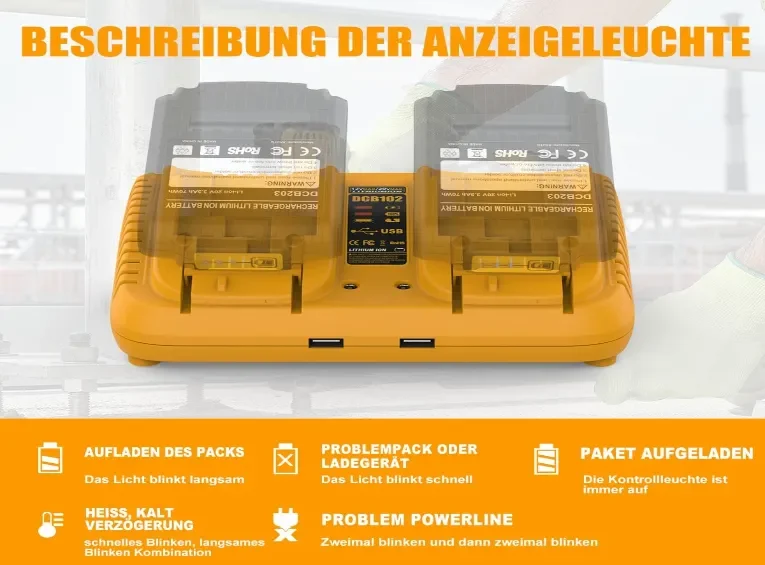DeWalt Charger LED Signals: A Pro’s Diagnostic Guide
On site, lost time equals lost revenue. When a DeWalt charger starts blinking, guessing isn’t an option. This guide decodes every LED state, explains what’s really happening inside the charger or battery, and gives step-by-step pro actions. Codes vary slightly by model (DCB107, DCB115, DCB118), so always confirm against the manual — but the field workflow here is designed to cover 95% of real-world cases.

LED Signal Cheat Sheet
| LED State | Meaning | Pro Action Steps |
|---|---|---|
| No light | No power / dead charger | Check outlet, cord, fuse; replace charger if unresponsive |
| Solid red | Charging normally | Leave in place, monitor briefly |
| Solid green | Fully charged / float mode | Safe to remove or leave |
| Slow flashing red | Temperature out of range | Move pack to room temp (16–27 °C / 60–80 °F), wait 15 min |
| Fast flashing red | Battery fault / BMS issue | Clean contacts → swap-test with known good unit → quarantine if repeat |
| Alternating red/green | Conditioning / handshake attempt | Wait 10–30 min; if no transition, isolate |
| Yellow/amber (some models) | Recovery/maintenance mode | Do not interrupt; may take hours |
| Rapid irregular blinking | Internal charger fault | Unplug, tag for repair or retire |
Pro Insight: Crews often misread “yellow” as a sign of success — but recovery mode is more like a hail-mary attempt. A healthy pack rarely ends up here.
Pro Troubleshooting Workflow
-
Safety first → check for swelling, smoke, or odor; isolate if present.
-
Verify power → test the outlet with another tool or light.
-
Clean + reseat → wipe contacts with isopropyl alcohol, reinsert pack.
-
Swap-test → cross-test suspect pack and charger with known-good units.
-
Check with multimeter → confirm pack voltage; far outside spec = battery fault.
-
Pinpoint fault → multiple packs fail in one charger = bad charger; one pack failing everywhere = bad pack.
LED + Symptom Mapping
-
No LED + outlet OK → blown fuse or PSU fault.
-
Solid red + never green → pack near end-of-life or failing charger capacitors.
-
Fast red flash + clean contacts → BMS trip or ID mismatch.
-
Slow red flash + cold site → warm pack for 30–60 minutes.
-
Alternating LEDs + stuck → handshake mismatch → test on another charger.
-
Yellow light for hours → extended recovery; possible but unreliable.
Fleet SOPs
-
Pre-shift checks → power on chargers, confirm LEDs respond correctly.
-
Charging rules → shaded, ventilated, fire-resistant surfaces only.
-
Quarantine process → tag suspect packs/chargers with ID, LED code, and time.
-
Incident logging → capture recurring LED faults; use logs to justify replacements.
Industry insight: Fleets that track LED incidents reduce “mystery downtime” by 30–40%. What looks like random faults often traces back to a single failing charger.
Tools Pros Should Carry
-
Multimeter (DC voltage, 0–20 V range)
-
Isopropyl alcohol + lint-free swabs
-
IR thermometer (flag surfaces >45–50 °C)
-
Known-good OEM charger (baseline testing)
-
Log sheet or mobile app for ID/LED tracking
Repair vs Retire
-
Repair charger: cord, fuse, spring contacts — if quick and cost-effective.
-
Retire charger: burned PCB, melted housing, repeated thermal or LED faults.
-
Retire battery: swelling, electrolyte smell, locked-out BMS, or visible leakage.
Cost logic: A $60–$90 charger isn’t worth field repair if downtime costs hundreds per hour. Treat chargers like consumables, not crown jewels.
When Hardware Fails
If diagnostics confirm a bad charger or pack, replacement is almost always the most economical choice. Crews lose more in wasted labor waiting for “repairs” than in buying a new OEM or certified compatible unit. Standardize procurement so supervisors can swap bad units immediately without long approvals.
👉 [See DeWalt-compatible chargers] | [See pro-grade replacement batteries]
Conclusion
Think of LED codes as your first diagnostic layer. Decoding them quickly, applying swap-tests, and following SOPs will keep projects moving while protecting crews. With discipline in logging and clear retirement rules, fleets minimize downtime and avoid unsafe guesswork. Keep this guide on hand — the next time a charger blinks red at the wrong moment, you’ll know exactly what to do.
FAQs
Q: Charger stuck on solid red, no heat — what’s wrong?
A: Likely a pack at end-of-life. Confirm by swap-testing with a known good unit.
Q: Is yellow light always good?
A: No. It means recovery mode. Sometimes it helps, but frequent triggers usually mark an aging pack.
Q: Do aftermarket chargers use the same LED codes?
A: Good ones often mimic DeWalt’s logic, but cheap units vary. Always confirm signals before rolling them out fleet-wide.